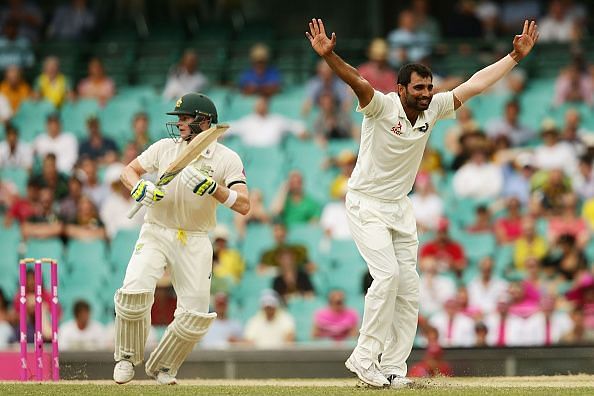
India's pace quartet: A new hope

In the recently concluded Test between India and Sri Lanka at the Eden Gardens, Indian fast bowlers took all the 17 Sri Lankan wickets, which fell during the match. The two Indian spinners – R Jadeja and R Ashwin, ranked 3rd and 4th in the world respectively - went wicketless.
Even after taking into account the grey skies and the damp pitch in Kolkata, it’s a rare feat by an Indian pace attack, especially in a home Test.
For the first time in Indian cricket history, the team boasts of an all-weather attack capable of restricting and taking wickets under different conditions and that too while bowling at 140kph. India now has four pace bowlers at its disposal, all with slightly different skillsets.
Umesh Yadav who made his debut in 2011 seems to have finally come of age especially after his fiery spell in Dharamsala earlier this year, blew away the Australian top order in a spell of fast bowling seldom seen in India.
Earlier known only for his pace and swing, he has now learned the art of bowling tight spells resulting in breakthroughs when the conditions are not supporting him.
Mohammed Shami
Mohammed Shami, after bowling a brilliant spell of reverse swing against the West Indies in his debut series in 2013, lost his mojo for a while and was even dropped from the side. Being injury-ridden, he lost a bit of pace and wasn't as effective when swing wasn't on offer.
But after returning to the team on the back of impressive performances in the Ranji Trophy he has emerged as the leader of the attack and is almost always an automatic pick for a Test. He seems a much more complete bowler now with the ability to swing the new ball at high pace. With the old ball he is an even bigger threat with his reverse swinging yorkers. He can also, if required, perform the restricting role from one end.
In the last five Test matches he has picked up 21 wickets at an average of 19.57 and a strike-rate of 37.90, which is a remarkable achievement for any fast bowler in India.
Ishant Sharma
Since the time Ishant Sharma bowled that spell to Ricky Ponting at the WACA in 2008, he has been in and out of the team owing to numerous injuries and subsequent loss in form. He seemed to have developed a habit of straying in line and length while his pace dropped appreciably.
With Kohli’s insistence on fitness and rotation, he has now started filling in the shoes he was always expected to. He can now bowl long spells while continuously attacking the batsmen with hostile pace and bounce.
Be it his 7-74 against England at Lords in 2014 or his brutal 8-86 against Sri Lanka at the Sinhalese Sports Club the next year – eventually setting up a series victory – Sharma has proved that he can be the tall angry fast bowler that Indian fans have always so wished for.
Bhuvneshwar Kumar
Bhuvneshwar Kumar, the fourth seamer in this quartet, impressed everyone with his booming in-swingers against Pakistan during his debut series. But as it has happened with the rest of the bowlers in this team - and many before them - he couldn't escape injuries. Soon, his speed went down and the swing was not as visible as it was early in his career. He seemed to have turned into a one-dimensional bowler.
But since his successive five-wicket hauls in England in 2014 he hasn’t looked back. His bowling average of 27.18 is currently the best among India’s fast bowlers. He has worked hard on his fitness enabling him to gain a yard or two in pace. He has also reinvented his bowling in the shorter formats, where he is now able to bowl yorkers and knuckle balls at will and with pinpoint accuracy.
Along with Jasprit Bumrah, the duo has emerged as a far more potent attack in ODIs than India have had in recent memory prompting the Australian captain Steven Smith to term them the “best death bowlers” in the world.
Indian cricket fans have seen a long line of fast bowlers bursting onto the scene but sooner or later losing pace and potency, especially due to injuries. In this context, the rotation policy employed by India to give regular rests to its premiere bowlers can't be overstated.
While not only taking care of the injuries, the BCCI and the team management have made sure that the bowlers, when they are not playing, maintain their fitness levels by sending them to the MRF Pace Academy.
It has also helped India that Kohli has the resources to choose horses for courses. If the conditions are expected to aid swing then Bhuvi is an automatic pick. Similarly if the pitch is fast and offers appreciable bounce then Umesh and Ishant come into the picture. Adding to this quartet, Jadeja and Ashwin are spinners who on their day can run through any batting order.
All that being said, this attack is yet to prove its mettle overseas, but judging by how the pace battery has performed over the last two years under the shadow of Ashwin and Jadeja on mostly spin-friendly pitches, the signs are quite encouraging. The prospect of Shami, Yadav, Bhuvi and Ishant locking horns against the likes of Amla and De Villiers in Cape Town when the New Year’s Test starts in January next year seems quite tempting now more than ever.
This Indian pace quartet has built its reputation over the last 3-4 years but the next two years with upcoming tours to South Africa, Australia and England are going to be crucial for them. Irrespective of what the results might be, these bowlers have certainly forced Indian fans to sit up and take notice while giving them a lot to cheer about on the way.